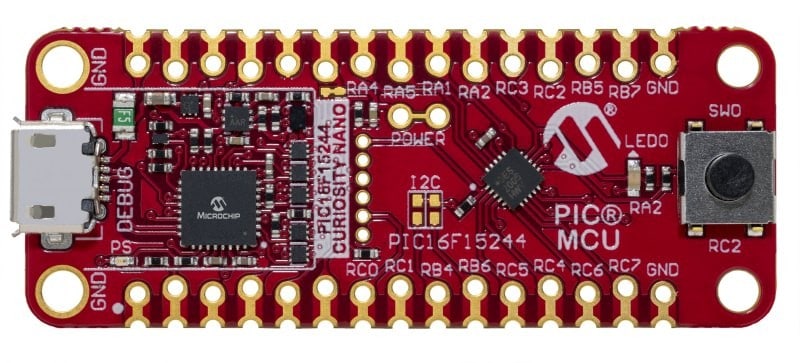Versatile MCUs for Cost-Sensitive, Space-Constrained Designs
The PIC16F15244 family of MCUs boasts a carefully cultivated array of on-chip Core Independent Peripherals (CIPs) that allow these small-form-factor microcontrollers (MCUs) to take on robust time-critical tasks. With its essential feature set, this product family is ideal for simple real-time control or as a companion MCU for more complex designs. Its built in ADC makes it perfect for large scale IoT sensor-based applications. This MCU family offers unmatched performance for its size and peripheral set while also providing the same user-friendly development experience as our more feature-rich PIC® MCUs.

Get Started with Curiosity Nano
The PIC16F15244 Curiosity Nano Evaluation Kit is the ideal platform for rapid prototyping with new PIC16F15244 family of MCUs. This USB-powered kit features an on-board programmer/debugger that seamlessly integrates with our award-winning MPLAB® X Integrated Development Environment (IDE). Its small form factor makes the board excellent for breadboard soldering, or you can combine it with the Curiosity Nano Base for Click boards™, which features multiple mikroBUS™ sockets so you can easily add sensors, actuators or communications interfaces from Mikroelektronika’s extensive selection of Click boards.

System Features
Advanced Memory Features
Memory Access Partition (MAP), Device Information Area (DIA)
Memory Access Partition (MAP) supports data protection and bootloader applications. Device Information Area (DIA) is a dedicated memory space for factory-programmed device ID and peripheral calibration values.
Integrated Analog
10-bit ADC
The on-board 10-bit differential Analog-to-Digital Converter (ADC) features selectable internal voltage references with minimal temperature drift. You can use its hardware averaging and oversampling to improve noise suppression and accuracy for analog inputs. Its averaging and threshold detection enables the MCU to remain asleep for longer periods, significantly reducing power consumption.
Layout Flexibility
Peripheral Pin Select (PPS)
Peripheral Pin Select (PPS) provides ultimate flexibility when routing digital signals to device pins. With PPS, any digital peripheral can be connected to any I/O pin on the fly for a customized layout. This allows you to maintain layout compatibility with older PIC® MCUs, even as new features are implemented.